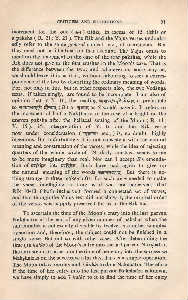Page 699 - Lokmanya Tilak Samagra (khand 2)
P. 699
CRITICISM AND SUGGESTIONS 51
increment for the odd ( Cfiif ) tithis, in excess of IS tithis or
a paksha ( R. 21; Y. 21 ). The Rik and the Yajus verses undoubt~
edly refer to the same general subject, viz., of increments. But
they need not be identical on that account. The Yajus omits to
mention the increment in the case of the t1na pakshas, while the
Rik does not give us the una amshas in the Moon's case. That is
the difference between the two; and whatever its cause may be,
we should leave it is as it is, without labouring to seek a corres-
pondence of the two by distorting the ordinary meaning of words.
For, not only in this, but in other respects also, the two Vedanga
texts, if taken singly, are found to be incomplete. I am also of
opinion that in Y. 16, the reading arTCfllf~cr~~s~~~ is preferable
to iffCfllf~~'ijf tl~~ (B) or ~~ as S would have it. It refers to
the increment of half a Nak~hatra in the case of a bright or the
uneven paksha after the heliacal setting of the Moon ( R. 11 ;
Y. 15 ). B's interpretation of Y. 16 and the Rik verse
now under consideration ( ~~o etc., ) is, no doubt, highly
ingenious. But unfortunately it is not consistent with the natural
meaning and construction of the verses; while the idea of rejecting
quarters of the whole circle of 124 daily amshas, seems to me
to be more imaginary than real. Nor can I accept S's emenda-
tion of i:!ll11"~ into ~- Both have had again to give up
the natural meaning of the words q~'WRr.· But there is no-
thing strange in these make-shifts; for such were needed to make
the verses intelligible so long as it was not perceived, that
Rik 10-13 (both inclusive) formed a connected set of verses,
and that though the Yajus text did not show it, the original order
of the verses was happily preserved for us in the Rik text.
To ascertain the time of the Moon's entry into the last parvan
Nak!Jhatra at the end of any given number of pakshas when the
said number is not exactly divisible by twelve, is a rather complex
operation and, therefore , the subject could not be finished in a
single verse. But not so with other cases. After determining the
time (in kalas) of the Moon's entry into the last parvan Nak~hatra,
the next step is to ascertain the time of her entry into the successive
Nak~hatras on the successive tithi day. This is a simple operation.
The Moon takes one day and 7 kalas to do a Nak~hatra. Therefore
if the time of her entry into the last parvan Nak!)hatra is known,
we have simply to add 7 kalas to it to find the time of her entry

